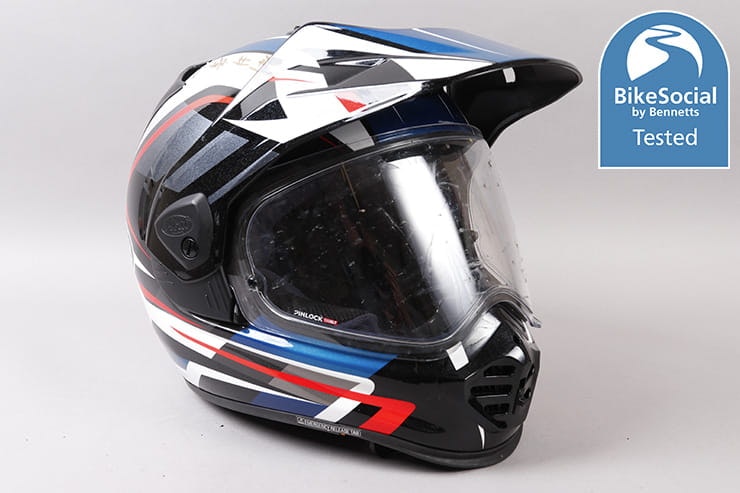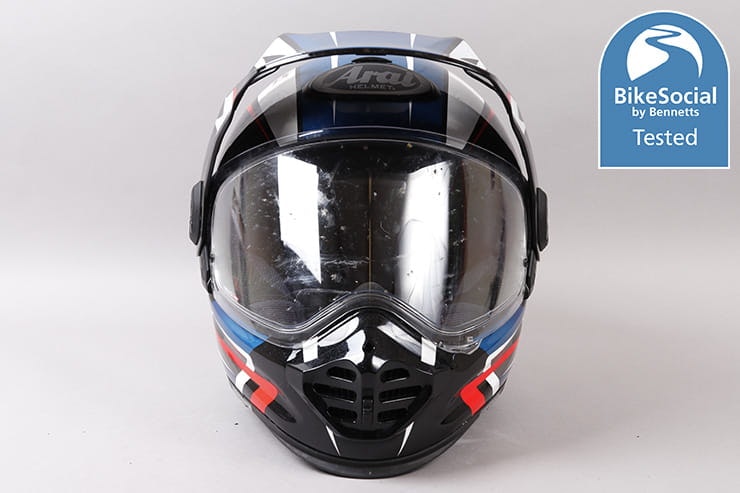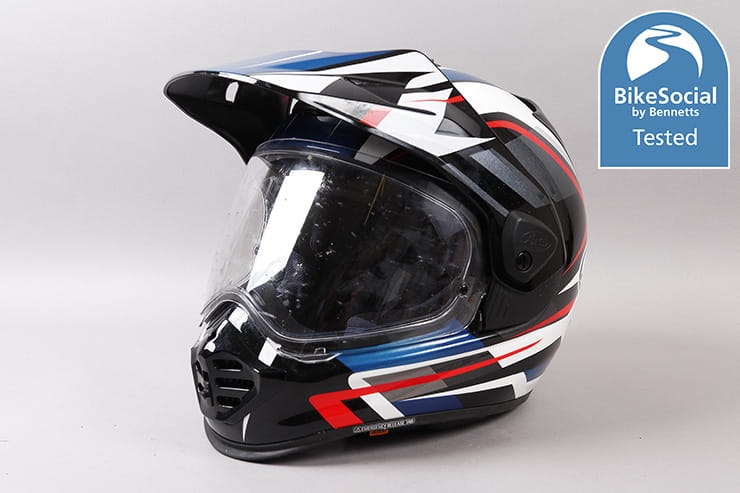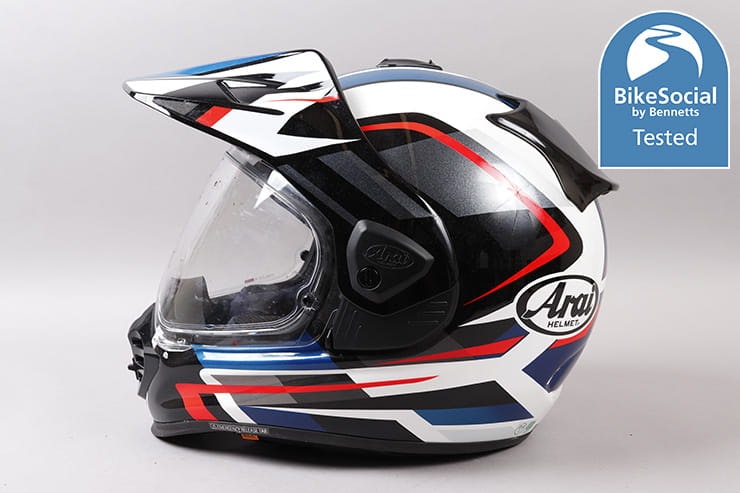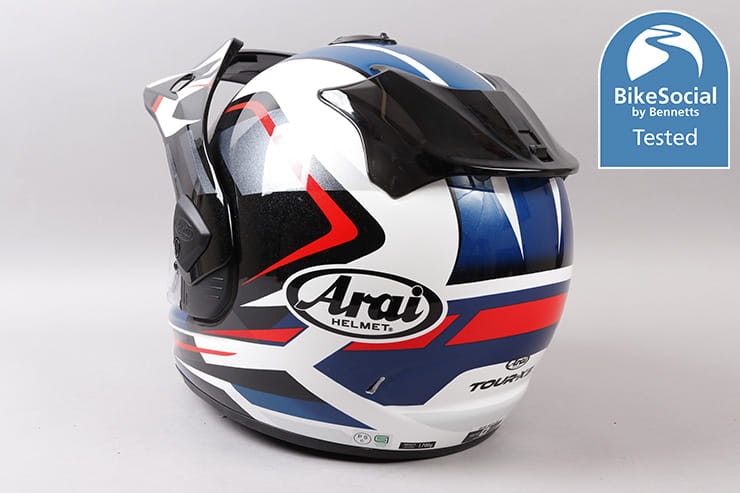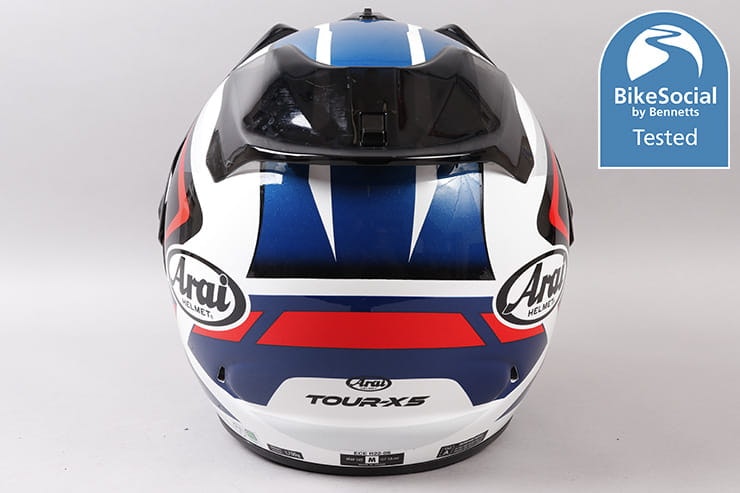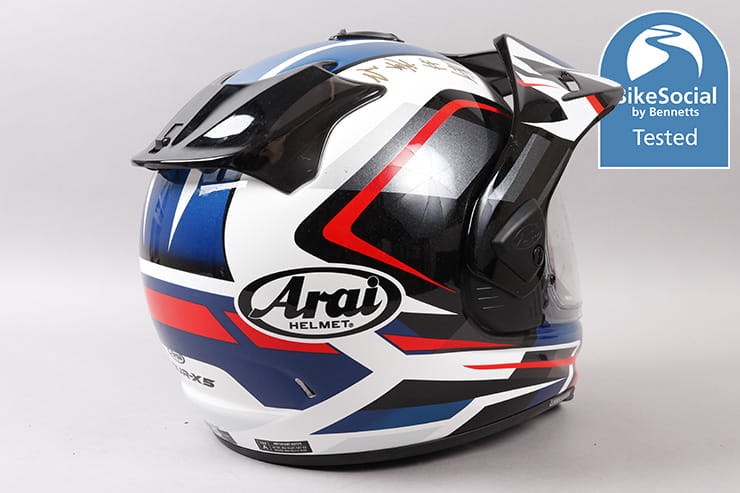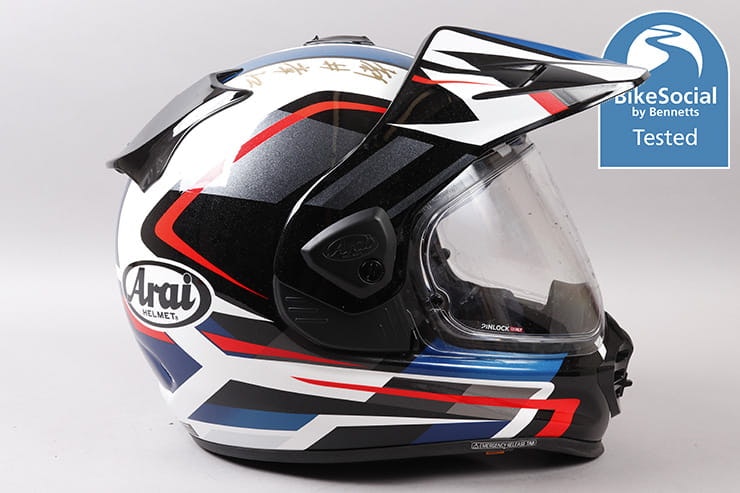Arai Tour-X5 review | Benchmark adventure helmet 1,000 mile test
By John Milbank
Consumer Editor of Bennetts BikeSocial
30.10.2023
Please note that the Kanji on the top of this helmet does not feature as standard
Date reviewed: October 2023 | Tested by: John Milbank | Price: From £599.99 | www.whyarai.co.uk
At the time of writing, the Arai Tour-X5 on review here hasn’t been officially released, but I’m among a handful of riders from across the globe to get hold of the first from the production line.
After over 1,000 miles in all weathers on a BMW R1250GS, a Honda Transalp and a Honda VFR800, I’m able to give you a full and honest opinion of whether it’s worth the money, or if you should pick up a cheaper Arai Tour-X4 (or indeed go for another brand altogether)…
A truly versatile helmet
Vastly improved visor mechanism with great field of view
Excellent ventilation
Like all peaks, it adds drag
Peak can drum slightly, though better than many others
No drop-down sunshield (which shouldn’t be a surprise)
1,000 miles with the Arai Tour-X5
An in-depth look at this new adventure helmet
Outer shell
While continuing with Arai’s ethos of keeping as round a shape as possible to the outer shell – in order to ‘glance off’ in an impact and reduce the energy transmitted to the brain – the Tour-X5 has been significantly redesigned.
One of the most obvious changes is the lowering of the visor mounting points, which is something that’s been done to most of the Arai range over the past few years (after which, they scored better in the SHARP testing methods). Interestingly, the ECE22.05 RX-7V had already had the mountings lowered, and that helmet passed ECE22.06 in the form of the RX-7V Evo with no significant changes.
Whether the new Tour-X5 would have passed this tougher standard without the changes isn’t known, and independent lab testing has occasionally highlighted areas in which some brands have beaten Arai. But with every crash being different it’s impossible to say with any authority whether Arai’s claims that it makes the safest possible helmets are true or not.
Designing protection for both high and low speed impacts is always going to be tricky, and Arai believes that, while it of course meets all the standards required by law, its own in-house testing, along with its decades of racing crash research, proves that its unwavering dedication to a very strong, hard outer-shell – and as soft as possible inner – is the best solution.
Paint finish is, as you’d expect, exceptional
The Tour-X5 uses Arai’s super-fibre shell construction, which is said to have 40% greater tensile and compressive strength than regular glass fibre, partly thanks to having much finer strands and a unique resin. It’s also got Arai’s Periphery Belt strengthening the area around the visor port; like all Arais, this is an incredibly strong outer shell.
Whether Arai does make the safest helmets is not something I can prove, but I would say that, having visited the factory in Japan and met Michio Arai – as well as his son Akihito – I am convinced that they believe they’re offering the best protection possible.
And they don’t make it easy on themselves. Arai is the only helmet manufacturer to make the EPS (expanded polystyrene) inner shell out of one piece of multi-density material. While all other brands use separate parts, each with a different density for different levels of softness, Arai has found a way to blend them into one piece with greater overall integrity yet very different levels of compression in the various areas. Not only is this far more expensive, it’s also a lot harder to get the inner shell inside the outer one, especially when that outer is so strong. But Arai believes this is the safer way to make its helmets, even if most buyers have no clue what’s going in inside.
Other noticeable changes to the shell include a rounder front, which carries on into the visor to have less of a pointed design. There’s also 10mm extra width at the cheeks due to this, which contributes to that ‘rounder, safer’ construction, as well as making it easier to pull on.
As you’d expect of a premium helmet – which is entirely hand-made, even down to the painting – the finish is excellent, the hand-laid decals on this graphics version, which costs £699.99, sitting under a metallic-fleck lacquer. Plain colours cost £599.99
The Arai Tour-X5 (sometimes known as the XD5) should be in dealers in December 2023 for plain colours, with graphics to follow in January. Prices in Europe are 879 Euros for plain colours and 979 Euro for graphics.
The Arai Tour-X5 uses three different outer shell sizes covering head sizes of XS to XL, so someone with a small head can buy a helmet that doesn’t look ridiculously big on them, and that’s designed to offer the ideal ratio of outer shell and inner EPS (expanded polystyrene).
The peak leaves enough space to tuck goggles, if you use them. The rear exhaust vent wing acts as a stopper for the goggles strap
Arai Tour-X5 peak
Being an adventure helmet, the Arai Tour-X5 does of course come with a peak fitted, which serves two main purposes:
To shield you from mud and stones that might be thrown up by a bike in front of you when riding off-road
To help prevent you getting dazzled by low sun, which is far more likely to be useful to the majority of riders.
Compared to the Tour-X4’s peak, this is new shape with a cut-out to the rear designed to allow smoother airflow. While it doesn’t look like it at first glance, I measured the new peak to also extend a useful 7mm further out from the top of the visor aperture, for even better sun protection.
But fitting a peak to a helmet will always have limitations, and at motorways speeds and above, the drag can be significant, depending on the screen fitted to your bike. On the Transalp and R1250GS (with standard screens) the Tour-X5 was fine for my 5’10” frame, but if I put my head out into the clear airflow there’s noticeable – and expected – drag when looking left, right or up.
On the GS, I also noticed that at high speeds behind the screen in its lowest position, a little pressure can be felt pushing down on the front of the peak, though not to any troublesome extent.
The Tour-X4’s peak used to drum a touch at speed, depending on the bike’s screen, and on the GS the Tour-X5 is no different. However, as with the previous lid, this can be reduced by adding some adhesive wheel weights.
Whether the drumming bothers you, or indeed if you notice it at all will depend on your bike and how you’re riding it, but it is to be expected with any adventure helmet.
Fortunately, like with the previous model, there’s no noticeable flapping or vibration of the peak to distract you – some adventure lids I’ve tried (like the Schuberth E1) flap around annoyingly while riding.
The Arai Tour-X5’s peak can be removed with just one plastic screw on either side of the helmet. Once taken out, no other parts are needed to replace the cover and screw, then ride with the peak removed. This really is a brilliant solution that makes it pretty quick and easy – as long as you have a small coin or a large, flat-bladed screwdriver such as on a penknife or multi-tool – to pop the peak off, or to refit it. My only criticism is that I’d have preferred the screws to have been in some way retained on the plastic covers as they’re a little easy to drop if you’re taking it off at the side of the road.
Using plastic means the screws can shear in the event of a crash – Arai designs all the external parts of its helmets to disconnect if there’s an accident – but they’re plenty strong enough, despite being a little easy to mark with tools. Better this soft plastic showing some indentations than being brittle and snapping when tightening up.
The peak can be adjusted up and down, but I prefer it in the lowest position to best block the sun.
Weight
The weight of helmets in general has seemed to even out a bit since the introduction of the tougher ECE22.06 standard. While Arai has a reputation for being ‘heavy’, this is a bit of a trope, and I can honestly say that I’ve not used any helmet that’s weight has caused me any issues; aerodynamics are far more important.
At speed, any adventure lid is potentially going to cause more strain on your neck than a standard full-face, but even after a full day on the Transalp and the GS, I didn’t have any issues with the Tour-X5. And with the peak removed, it’s a sleek design that cuts through the air very easily.
I measured the Arai Tour-X5 to weigh 1,736g with the peak fitted, compared to 1,710g for the Tour-X4 and 1,601 for the ECE22.05 Shoei Hornet ADV.
The inner EPS has a total of eight ventilation ports to cool the head, which isn’t counting the mouth vent
Ventilation
Ventilation on the Arai Tour-X5 is excellent, with a two-position and closed chin vent that directs air up across the back of the visor and towards the brow. It also has a slider inside to allow air to blow straight to the mouth if you want it.
The forehead carries the open or closed Arai logo vent that was first seen on the Arai Quantic (review here), and that delivers a very good flow of air to the head and across it, without creating the ‘cold spot’ blasts in localised areas of the head that some can. This vent is ideally positioned to scoop air in, my only criticism of it being that it can be a little trickier to keep clean during a summer thick with bugs.
At the top of the shell is a two-position and closed additional intake, with the two-position and closed exhaust vent in the rear spoiler revealing two ports that draw stale air out. Additionally, there are two small slots at the lower rear of the shell, to further pull air out.
Something I’ve really noticed while wearing the Tour-X5 is that I’m flicking the visor open a lot less. As a glasses wearer, I often pop the visor open as I pull to a stop at lights, but the airy feel of this Arai has really reduced that.
And yet it’s not too drafty. You can feel air moving around your face to some extent, as well as a light but comfortable breeze around the bottom (it’ll depend on your bike’s aerodynamics), but I haven’t felt cold in this yet. However, if you’re going to wear this through deep winter and want to seal yourself off more, an optional chin skirt – the same as is supplied with the Arai RX-7V Evo (review here) – can be bought separately, though it is about £30. It’s a shame it’s not included, though despite having one to hand, I haven’t felt the need to install it myself yet. The fitted small chin skirt also pulls down a little to further extend the wind protection around this area.
The visor vents that are typical of most Arais are gone on this new adventure helmet, but due to the effectiveness of the logo vent they’re not needed. Removing them has created more space in the visor port, making riding with goggles a lot easier.
Overall, the Arai Tour-X5 has excellent venting thanks to some cleverly positioned ports – there are eight in the inner shell, plus the mouth vent – and the well-designed lining, which allows the air to move freely around your head, not just blow onto one spot.
One relatively minor point to note about the rear spoiler vent is that it makes the overall size a little longer, which means it’s a tight fit to get it into my 52 litre Givi Trekker top-box, regardless of whether you have the peak fitted. It’ll go, but not as easily as the Tour-X4, and you might struggle to get two helmets in.
Visor
The Arai Tour-X5 visor mechanism is probably the biggest single improvement over the previous model thanks to the fact that it requires no tools to remove. The peak is held in place with two screws, but these are attached to the visor mechanism covers, so just open the visor, press the buttons on either side of the covers and they pop off easily. Then flick the visor out for easy cleaning, or to remove it altogether and run with googles. As with removing the peak, there are no additional parts required to carry, so this really couldn’t be any easier.
The visor mechanism has also been designed to resist scratching and jamming from any dust getting into it. As with most adventure helmets, the visor doesn’t open all the way up out of view – the bottom is visible, though not in your normal line of sight.
Refitting the visor is a technique you’ll quickly grasp, and just needs the pin on either side holding in as you rotate it into place. The covers need hooking in properly, but it’s obvious if you haven’t done it correctly, and after a few tries you’ll be whipping the visor out and back in in no time.
A Pinlock 120 XLT is supplied, the 120 meaning it’s the highest spec and most resistant to fogging, the XLT standing for ‘eXtra Light Transmission, and the new visor is more round than the previous, more ‘pointy’ version. It also has a double-curvature and is said to create less distortion than the old model (though I hadn’t really noticed a problem).
The field of view from the Arai Tour-X5 is outstanding; being an adventure lid, having such an immersive, panoramic view is great, whether you’re wearing the peak or not. As a helmet for getting out and enjoying stunning scenery, this is a great choice.
Of course, being an Arai there’s no drop-down sun-shield, and this will be a deal-breaker for some. Arai firmly believes that to fit one compromises ultimate safety (beyond the legally-required standards), but it’s a choice only you can make. You can of course buy a dark-smoke visor for it, which I prefer on very bright days as it means just one piece of plastic in front of my eyes, as opposed to the clear visor, Pinlock and a drop-down sun-shield I’d have otherwise.
But don’t underestimate the value of that peak, which is absolutely brilliant in low-sun conditions, especially in Autumn. Being able to block the sun altogether with a tip of the head is a huge safety benefit.
I’ve had no issues with the visor leaking on the road or during a hose test, but the visor fixing plates on the new Tour-X5 (XD5) are adjustable, so if this were ever to be an issue, you – or your dealer – should be able to reposition them for a perfect seal.
As mentioned, fitting goggles to the Arai Tour-X5 is easier thanks to the removal of the visor vents, but also due to a re-shaping of the nose guard, which is now flatter and doesn’t need pulling out to get my 100% Barstows inside.
Cleverly, the rear spoiler also acts as a retainer for your google’s strap, stopping it pinging off the top of the lid, while there’s just enough space under the peak for me to tuck the googles when taking the lid off, or if I just need them out of the way briefly (putting them over the chin always ends up in them getting fogged by my breath).
Arai Tour-X5: True versatility
It’s no exaggeration to say that the Arai Tour-X5 is four helmets in one, thanks to the brilliantly-designed new visor mechanism making it so easy to remove, and the simplicity of two screws to whip the peak off, without needing to carry any spare parts to swap out. Here are your options…
Adventure lid with peak and visor
Adventure lid with peak and goggles
Fast road helmet with visor
Street-style with goggles
The styling of the helmet is, to my eyes at least, so good that it can work as well on a scrambler in the city as it does on a trail bike on the Trans-European Trail, or indeed on a sportsbike on the open roads.
Lining
The cheek pads have been redesigned on the new Tour-X5 to hold against the base of the jaw more, creating a less tight, but still stable, comfortable fit, while the lining has a water-repellent finish and an ‘Eco Pure’ antibacterial, deodorising fabric that’s said to maintain your skin’s natural PH of around 4.7.
Sweat and soap can make your skin more alkaline, so this fabric is claimed to reduce smells and rough skin, as well as being easy to keep clean.
As to the effectiveness of that, I couldn’t promise you at this stage, but I can tell you that it feels good, and I haven’t had any problems with it getting damp from sweat or rain.
The cheek pads and skull cap have removable foam sections that are 5mm thick for a more custom fit. These are lightly glued in place, so take care if you pull them out, in case you end up wanting to put them back. If you still can’t quite get the perfect fit, different size cheek pads and skull cap can be fitted by good dealers, and should be done for free.
The Arai Tour-X5’s lining is fully removable for easy cleaning. It should be hand washed, but I tend to put the parts in the helmet bag, tie that closed and run a gentle wash in the machine. Just don’t blame me if that goes wrong for you!
Fastening
As is the case with all Arais, the Tour-X5 is fastened with a double-D strap. While this can’t be opened or closed with gloves like the micro-metric ratchet straps fitted to some other brands, it does ensure a secure fit every time, and is comfortable and lacking in any unnecessary bulk.
Fit
Arai makes two different helmet shapes – a more round design for the Asian markets, and a narrower, longer one for the European and American riders. The outer shells are the same, but it’s the internal EPS liners that are slightly different.
Fit is utterly subjective. I’ve always found Arais fit me well, but this was the first one that didn’t seem quite right at first to me. Interestingly, a couple of other people who were with me when we collected them said that this was the first time an Arai had fit them so well straight out of the box; I had a red mark on my forehead after an hour or so of use.
I removed the additional inserts in the fabric liner to give it a bit more room, but usually an Arai Pro Shop dealer would swap the liner for an even thinner one altogether. These weren’t available this early in the production schedule, but an additional padded liner was added to the crown to lift the helmet up a bit on my head.
While this was more comfortable, I found that at high speed when on my GS the peak would cause the helmet to rotate downwards. I removed the additional padding and found that the helmet had broken in by this point – thanks no doubt to the extremely soft inner shell – and it now fits me perfectly as standard.
It’s always vital to have a lid that fits you properly, and the premium brands will do all they can to ensure that this is the case when buying. Given the extra force that can be applied by the wind to a lid with a peak, you must get one that’s tight enough.
Fit is of course very subjective, so try any lid before you buy, but the soft interior of Arais does tend to make them very compliant. Some cheaper helmets with harder inner linings can be a lot less comfortable, especially when new.
Arai Tour-X5 noise
A peak will always add noise to any helmet – at worst it’s a vibration that irritates the hell out of you, at best it’s a slight extra bass note, or light drumming, as is the case with the Tour-X5. I’d say it’s pretty much the same as on the Tour-X4, but it really does depend on your bike and its screen as it’s buffeting from here that causes any noise; in clean air (so perhaps with a short rally screen) there’s no additional noise from this peak, though of course at high speeds the drag will become significant.
I’ve been surprised at how quiet the Tour-X5 is for normal wind noise, which is perhaps why I notice the bass-note that the peak can add. I’ve reduced this – as I did on the Tour-X4 – by adding some self-adhesive motorcycle wheel weights to the underside of the peak, but it depends very much on where I position the screen. With both lids, I find it best to have my GS’s standard screen at its lower position while riding with the peak; there’s no problem with drag until I get to high motorway speeds, and the additional noise is kept to a minimum.
Of course, any helmet requires earplugs over about 40mph, so whether you’re riding with the peak fitted or not, please do wear them as tinnitus in later life is no fun at all.
For more information on why earplugs are vital with any helmet, and advice on which are the best, click here.
Can you fit an intercom to the Arai Tour-X5?
The Arai Tour-X5 has been designed to take an aftermarket intercom of your choice thanks to a flat section on the sides giving ample room to stick it.
Usually, speakers are fitted into the cheek pads of Arais, but there are now recesses ready behind them, making fitting much easier as well as causing a lot less hassle when removing the liner for cleaning – something important on a helmet that’s more likely to be used in dusty environments.
Brilliantly, the neck skirt also has pockets built in to accept the wiring from an intercom, so whether you’re fitting a Cardo or Sena – or pretty much and other intercom – the Arai has been designed to let you do that. There’s even a Velcro patch preinstalled in the chin section for your microphone!
The Tour-X5 (right) is significantly different in many ways to the Tour-X4 (left)
Three alternatives to the Arai Tour-X5
The popularity of adventure bikes means there’s a fair choice when it comes to lids with a peak. Whether you really need that peak is up to you, but the Tour-X5 offers the best versatility of any adventure helmet I’ve tried so far. What matters most of course is that any helmet fits you properly, so here are some others to consider…
Shoei Hornet ADV. The most obvious competitor to the Arai, the Hornet was perhaps the more road-focussed lid when compared to the outgoing Tour-X4, but that’s not the case when compared to the more versatile Tour-X5. Still, we’re yet to see what the new ECE22.06 version brings… Full review of the ECE22.05 Shoei Hornet ADV here.
Arai Tour-X4. There’ll likely be deals to be had on the Tour-X4 as stock is cleared, so it’s worth considering. I’ve seen them as low as £399.99 for plain colours, which is a £200 saving on the RRP of the new model and not to be sniffed at. But, the changes to the new Tour-X5 are significant enough that, honestly, I’d recommend saving for the new model. Full review of the Arai Tour-X4 here.
HJC C80. It’s cheaper, and it’s also a flip-front, so there’s a lot to like about the C80, but it’s not got the build quality or solidity of the Tour-X5 if a peak is what’s taking you here. Full review of the HJC C80 here.
These are just three of many alternatives – you can find all the motorcycle helmets we’ve tested here and be sure to regularly check for the discounts available through Bikesocial membership.
While there are some great deals on the Tour-X4 as stock is cleared, the new Arai Tour-X5 is significantly better in many ways
Arai Tour-X5 review: Verdict
The Arai Tour-X5 is a truly versatile helmet – far more so than any other adventure lid I’ve tried up until this point. In seconds, you can remove the visor and use it with goggles, or whip the peak off and ride in it as a standard full-face. If you want a cool street-bike style with googles but no peak, you can do that too. There are no spares to carry around, and only a coin is required to take the peak off. Brilliant.
An adventure helmet like this, with a peak, isn’t going to be for everyone, and if the majority of your riding is on motorways you’ll probably soon take that peak off. But the safety benefit of it in low sun means it’s spending a lot of time in place on my lid, and while the extra drag and drumming it can cause (depending on your bike) can take a little getting used to, it’s a fantastic piece of kit that, while not cheap, more truly offers four different helmets in one than any other I’ve tried.
If you’d like to chat about this article or anything else biking related, join us and thousands of other riders at the Bennetts BikeSocial Facebook page.
